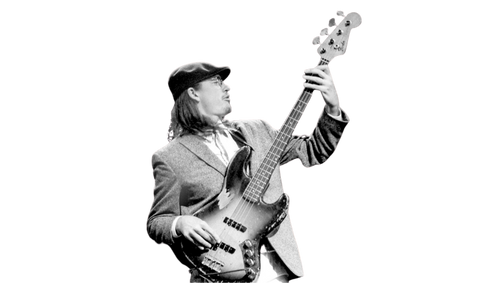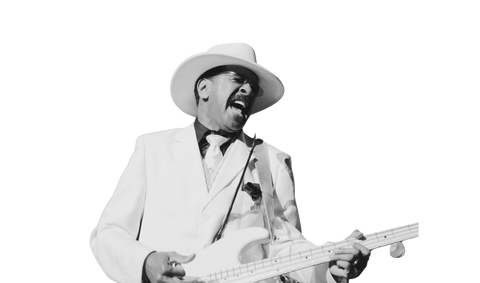
Bass Guitar Types, Techniques, and Gear
“The bass is the instrument that is the most important, yet the least understood.”
-Victor Wooten
Bass Types and Techniques
Let’s talk about the bass types that fill the world’s stages and studios. The electric bass guitar is the most common, with four-string models dominating genres like rock and pop. But dive deeper, and you’ll find a treasure trove of options. The five-string bass, for example, adds a lower B string, opening up new tonal possibilities that resonate with the low-end lovers among us.
“The more strings, the more opportunities for creativity.”
-Marcus Miller
Then there’s the fretless bass, which opens up a world of expressive possibilities. With no frets to dictate pitch, players like Jaco Pastorius used this instrument to create fluid, singing lines that revolutionized jazz and fusion. “I’m trying to make the bass sing,” Pastorius once said, and his innovative approach has inspired generations of players to do the same.
The Gear Behind the Sound
Now, let’s get into the nitty-gritty of bass gear. The right equipment can make or break a performance, and the bass world is no stranger to high-quality gear that has its own backstory. For instance, the iconic Ampeg SVT amplifier, known for its massive power and rich tone, was originally developed in the late 1960s. Its 300 watts of tube power made it a favorite for rock giants like The Who and The Rolling Stones. It’s the sound of an era, and to this day, players like Flea from the Red Hot Chili Peppers swear by its legendary punch. Effects pedals are another area where bassists have a plethora of choices. Compression, distortion, and envelope filters can all enhance a bassist’s sound. The Boss ODB-3 Bass Overdrive is a favorite among many, including Green Day’s Mike Dirnt, who uses it to achieve that gritty, driving tone that defines the band’s punk rock sound.

Secrets from the Pros
But beyond the gear and techniques, there are hidden gems of wisdom and quirks that seasoned bassists have learned along the way. For example, many bassists recommend using roundwound strings for a brighter tone, but there’s a growing appreciation for flatwound strings, especially in jazz. These strings provide a smoother, warmer sound, ideal for those intricate walking bass lines that make jazz so captivating.Additionally, the world of bass guitar brands is full of intrigue. For instance, the collaboration between Ibanez and bass legend Billy Sheehan led to the creation of the Sheehan signature bass, which features an extended range and a unique body shape. “The sound has to be clear,” Sheehan emphasizes, and his signature model is a testament to the pursuit of clarity and versatility.
The Rhythm of the Future
As Wooten also reminds us, “Bass players often have to serve two roles: they have to be a part of the band while also being the glue that holds everything together.” This duality is echoed in the variety of bass types available today, from the classic four-string Fender Precision to the sleek six-string Ibanez that allows for extended range and expression.As we look to the future of the bass guitar, it’s exciting to see how technology is shaping the instrument. Digital amplifiers and modeling technology are becoming more prevalent, allowing players to explore new sounds without the weight of traditional gear. However, the essence of the bass guitar remains unchanged—it’s still about that deep connection to music and rhythm.
The bass guitar has a rich history and an exciting future, filled with endless possibilities for exploration and expression. As the legendary Carol Kaye puts it, “The bass is the root of all music. It’s the heartbeat.” So whether you’re strumming on a classic Fender or exploring the depths of a boutique model, remember that every note you play contributes to the pulse of the music you love.
History of the Bass Guitar
The bass guitar holds a unique and essential role in music, laying down the foundation and driving the rhythm that defines the groove in countless genres. From rock and jazz to funk and metal, the bass delivers those deep, low-end frequencies that bring the music to life and tie everything together. Whether you're a seasoned player or just curious, this guide covers everything you need to know about the bass guitar—its history, types, anatomy, playing techniques, essential gear, and the legendary bassists who made it iconic.
In the 1960s, the Fender Jazz Bass (J-Bass) joined the lineup, featuring a slimmer neck and an extra pickup for a wider range of tonal options. This ushered in a new era for the bass guitar, and soon, other manufacturers like Gibson, Rickenbacker, and Music Man started producing their own electric bass models, each with distinct features. During the 1970s, players like Jaco Pastorius revolutionized the bass guitar’s role in jazz, demonstrating its melodic and harmonic potential. As technology advanced, so did the instrument, with improvements in pickups and electronics shaping the sound of the bass guitar for generations to come.The bass guitar is the unsung hero of music, a powerhouse that underpins the rhythm and adds depth to our favorite tunes. Its journey from humble beginnings to the center stage of musical innovation is a fascinating tale of creativity, evolution, and the relentless pursuit of groove. Buckle up as we take a deep dive through time, tracing the development of the bass guitar from its origins to the modern marvels we know today.
The Birth of the Bass: Pre-1900s
Before the electric bass guitar strummed its way into our hearts, the bass’s roots can be traced back to ancient string instruments. The double bass, for instance, emerged in the 16th century, providing a rich, deep sound in orchestras and chamber music. However, it wasn’t exactly designed for the fast-paced world of popular music.As music evolved, so did the need for a more versatile bass instrument. The 19th century saw the rise of the upright bass in folk and jazz, serving as the backbone of rhythm sections. This instrument laid the groundwork for what was to come, with its warm tones and resonance captivating musicians and audiences alike.
The Birth of the Electric Bass: 1930s
Fast forward to the 1930s, when a groundbreaking innovation began to take shape. The electric guitar was gaining popularity, and it became clear that a similar instrument was needed for the bass. Enter Leo Fender, the mastermind behind the first commercially successful electric bass guitar, the Fender Precision Bass, introduced in 1951.This instrument was revolutionary, allowing bassists to be heard clearly in bands, forever changing the landscape of popular music. As the legendary bassist Carol Kaye said, “When the Precision Bass came out, it was a whole new world. We could finally be loud!” The Fender Precision’s sleek design and powerful sound quickly made it the go-to choice for many musicians.
The Rock ‘n’ Roll Era: 1950s-1960s
The 1950s and 1960s marked the golden age of rock ‘n’ roll, and the bass guitar played a pivotal role in defining the sound of the era. The introduction of the Fender Jazz Bass in 1960 provided players with a new, brighter tone and more tonal versatility. This was the favorite of many iconic bassists, including Jaco Pastorius, who would later transform the way bass was played with his fretless style, adding a lyrical quality to the instrument.During this time, bassists like Paul McCartney and James Jamerson brought the bass guitar to the forefront of popular music. Jamerson, known for his work with Motown, used the bass as a melodic instrument, playing intricate lines that became the backbone of countless hits. His quote, “I’m not just playing the bass, I’m part of the song,” exemplifies the evolving role of the bassist in music.
Funk, Jazz, and Beyond: 1970s-1980s
The 1970s saw the bass guitar branching into new genres, with funk leading the charge. Players like Larry Graham popularized the slap and pop technique, making the bass not just a supporting instrument but a lead voice in funk bands. Graham’s innovative style became a blueprint for future generations of bassists, emphasizing rhythm and groove.In jazz, the use of fretless bass guitars became more prominent, with musicians like Jaco Pastorius taking the instrument to unprecedented heights. His album "Jaco Pastorius" (1976) showcased the expressive capabilities of the fretless bass, allowing for fluid melodies and complex harmonies. His influence can still be felt today, with countless players striving to capture that elusive, singing tone.
The Modern Era: 1990s-Present
As we entered the 1990s and beyond, the bass guitar continued to evolve. The introduction of the 5-string bass allowed players to explore lower registers, while advancements in technology brought about the use of digital amplifiers and effects. Brands like Warwick, Ibanez, and Ernie Ball Music Man began producing high-quality instruments that catered to diverse playing styles and preferences.
Today, bassists like Flea from the Red Hot Chili Peppers and Thundercat are redefining what the bass guitar can do, blending genres and incorporating modern techniques into their playing. The resurgence of interest in vintage bass models has also created a new wave of appreciation for classic instruments, with players seeking out rare and unique pieces.
Types of Bass Guitars
The bass guitar comes in various forms, each tailored to specific playing styles and musical requirements. The most common type is the 4-string bass, tuned E-A-D-G, which is the standard in genres like rock, jazz, funk, and blues. This configuration covers the essential low-end frequencies, making it a versatile choice for many bass players.
For those seeking an extended tonal range, the 5-string bass is a popular option, typically adding a low B string (tuned B-E-A-D-G). This low B expands the instrument’s lower register, making it ideal for genres like metal, gospel, and modern pop, where deep, rumbling bass lines are crucial. However, some players—such as Janek Gwizdala—prefer tuning their 5-string bass with a high C string instead of the low B (tuned C-E-A-D-G). This configuration offers more melodic possibilities, particularly for soloing and chordal playing, as the high C provides access to a wider range of upper-register notes.
The 6-string bass takes this even further, combining both a low B and a high C string (tuned B-E-A-D-G-C), offering both extended low-end power and high-range melodic flexibility. This configuration is often favored by progressive rock, jazz fusion, and experimental players who need more versatility for complex harmonies, solos, and intricate bass lines.
Each string configuration serves different musical goals, from delivering rich, deep tones to expanding the instrument's range for more melodic exploration. Whether focusing on the lows or highs, bass players can find a setup that suits their unique style and musical vision.
Fretted vs. Fretless Bass
A fretted bass has metal bars (frets) along the neck, dividing it into half-step increments. This makes it easier to play in tune and allows for clear, articulate notes. Fretless basses, on the other hand, have a smooth fingerboard, similar to an upright bass. This allows for a more fluid, expressive sound, with the ability to slide between notes (glissando). However, fretless basses require more precision in finger placement to stay in tune.
Electric vs. Acoustic Bass
While electric basses are the most common, acoustic bass guitars also have their place, particularly in unplugged settings or folk music. Acoustic basses are usually larger and can be played without amplification, though most come equipped with pickups for live performances.
How a Bass Guitar actually works
Understanding the components of a bass guitar can help you make informed decisions when choosing an instrument and allow you to optimize its setup for your playing style.
Bass Guitar Body
The body of a bass can be solid or hollow, with solid bodies (e.g., the Fender P-Bass or Ibanez SR series) offering greater sustain and resistance to feedback, while hollow or semi-hollow basses (e.g., Gibson EB-2) have a warmer, more resonant tone. The wood type used in the body also affects tone—ash and alder are popular for their balanced sound, while mahogany provides more warmth and sustain.
Bass Guitar Neck
The neck’s construction greatly influences playability and tone. Bolt-on necks, where the neck is screwed into the body, offer a snappier tone with more attack (common in Fender models), while neck-through designs, where the neck extends through the length of the body, provide better sustain and a smoother transition between notes (used in high-end models like the Ibanez SR1605DW). Scale length refers to the distance between the nut and the bridge. Long-scale basses (34 inches) are the standard, but short-scale basses (30 inches) offer easier playability, especially for players with smaller hands.
Bass Pickups
Pickups are magnets wrapped in copper wire, converting string vibrations into electrical signals. Single-coil pickups (used in the Jazz Bass) provide a bright, articulate tone but are susceptible to noise. Humbuckers (used in Music Man StingRay) cancel out noise and offer a thicker, punchier tone. Some basses use active pickups, which require a battery and provide more output and tonal flexibility, while passive pickups rely solely on the string vibrations and are known for their vintage warmth.
Bass Guitar Bridge and Nut
The bridge and nut anchor the strings at both ends of the instrument. A high-quality bridge (like a Badass II or Hipshot) ensures stable tuning and proper intonation, while the nut controls string spacing and height at the neck. Adjusting the bridge can improve playability by lowering or raising the action (the distance between the strings and fretboard).
Bass Guitar Tone and Volume Controls
Bass guitars typically have tone and volume knobs for each pickup, allowing players to blend different tones. For example, blending the neck and bridge pickups on a Jazz Bass can create a rich, scooped tone ideal for slap bass.
Bass Guitar Strings
Strings are made from various materials, each affecting tone and feel. Stainless steel strings are bright and long-lasting, while nickel strings are warmer. Flatwound strings offer a smoother surface, producing a darker, more mellow tone (great for jazz), while roundwound strings have more brightness and sustain (preferred for rock and funk).
Bass Guitar Techniques
The bass guitar may seem straightforward, but there’s a wide range of techniques that can bring it to life.
Bass Fingerstyle vs. Pick
Fingerstyle involves plucking the strings with your fingers, producing a warm, round tone. This technique is versatile and used in many genres, from jazz to rock. Picking, on the other hand, creates a sharper, more aggressive sound, ideal for punk, metal, and some rock styles. Some players, like John Paul Jones of Led Zeppelin, switch between both depending on the song.
Slap Bass
Popularized by players like Larry Graham and Flea, slap bass involves striking the string with the thumb (slap) and pulling it with the fingers (pop). This creates a percussive, rhythmic sound often associated with funk but also heard in rock and jazz.
Bass Tapping
A more advanced technique, tapping involves using both hands to press the strings on the fretboard, allowing for rapid, melodic playing. This is often seen in progressive rock and fusion (e.g., Billy Sheehan’s work).
Bass Palm Muting
Placing the side of your palm near the bridge while plucking the strings produces a tight, percussive sound. It’s a subtle technique but can add depth and groove to your playing, especially in funk or jazz settings.
Bass Guitar Harmonics
Harmonics are achieved by lightly touching a string at specific points (usually the 12th or 5th fret) and plucking. This creates bell-like overtones, adding texture to your playing. Some players, like Jaco Pastorius, use harmonics to create atmospheric, melodic passages.
Essential Bass Gear
Your bass rig is just as important as the instrument itself.
Bass Amplifiers
A good bass amp can make all the difference in your tone. Bass amps generally come in two forms: combos (amp and speaker in one unit) and stacks (separate head and cabinet). Amps like the Ampeg SVT provide a classic, tube-driven sound, while brands like Bergantino offer modern, high-fidelity solid-state options like the Forté HP2.
Bass Effects Pedals
Pedals are a great way to expand your tonal palette. Distortion and overdrive pedals (like Darkglass B7K) add grit and punch, while chorus and reverb pedals can thicken your tone. Compressors even out your dynamics, especially helpful for slap bass. Octave pedals are also popular, adding an extra low-end punch by doubling your notes an octave below.
Bass Strings
Aside from the material mentioned above, string gauge affects playability. Heavier strings (thicker gauge) produce more tension and fuller tone but are harder to play. Lighter strings are easier to bend but may lack some punch in lower registers.
Bass Guitar Straps, Cases, and Accessories
A well-padded strap is crucial for comfort, especially during long gigs or rehearsals. Hard cases protect your bass from damage, while gig bags are lighter and more portable. Other accessories include string cleaners, tuners, and extra picks (even if you’re primarily a fingerstyle player).
Iconic Bass Players and Their Gear
Jaco Pastorius revolutionized bass playing with his fretless Fender Jazz Bass, combining jazz and fusion influences with a lyrical, melodic approach. Paul McCartney, often seen with his Hofner violin bass, helped define the bass guitar’s role in pop and rock. Geddy Lee of Rush mastered complex, multi-layered basslines with his Fender Jazz Bass, often playing both bass and keyboards simultaneously. Flea from Red Hot Chili Peppers brought slap bass to the mainstream with his Music Man StingRay, while Cliff Burton of Metallica pushed the limits of bass distortion and effects.
Tips for Buying a Bass Guitar
When buying a bass, consider your budget and playing style. For beginners, brands like Epiphone and Squier offer affordable, reliable instruments. Intermediate and advanced players might look to Fender, Ibanez, or Music Man for more versatile options. Always play the instrument before buying—check for comfort, neck profile, weight, and tonal flexibility. Used basses can be a great option, but inspect them for any potential damage, especially around the neck and electronics.
Maintaining and Caring for Your Bass
Regular maintenance is key to keeping your bass in top shape. Clean your strings with a dry cloth after each use to remove sweat and dirt, and replace them when they lose their brightness. Adjust the action and intonation as needed, ensuring the strings are properly spaced and the bass plays in tune up the neck. Store your bass in a cool, dry place to avoid warping, and if possible, invest in a humidifier to keep your instrument safe from environmental changes.
Conclusion
This comprehensive guide to the bass guitar covers everything from its rich history to essential techniques, gear, and legendary players. The article explores the evolution of the bass guitar, starting with the iconic Fender Precision Bass in the 1950s, leading to modern variations like 5- and 6-string bass guitars. Readers will find in-depth information on different types of bass guitars, including fretted vs. fretless and electric vs. acoustic models. The anatomy of the bass guitar is explained in detail, with sections covering the body, neck, pickups, and strings. Popular playing techniques such as fingerstyle, slap bass, and harmonics are broken down to help bassists improve their skills. Additionally, the article highlights essential bass guitar gear, including amplifiers, effects pedals, and accessories, and offers tips for selecting the right bass guitar for your style. With insights on iconic bass players and their gear, this guide serves as the ultimate resource for anyone looking to master the bass guitar.
Photo Credits. 1.(Jaco Pastorius, Jazz at the Opera House, San Francisco CA. Photo: Brian McMillen) 2. (Billy Sheehan by Tilly Antoine.)






